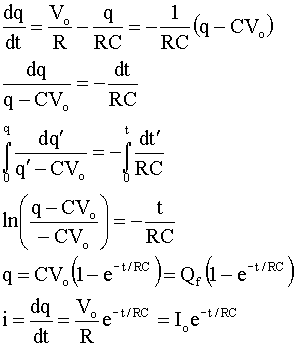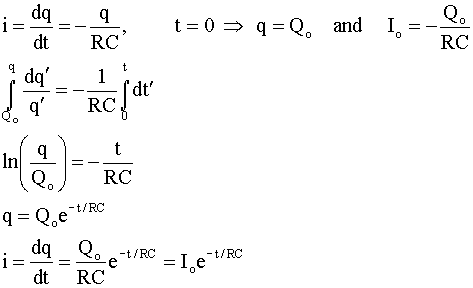|
Phys 4, Section
2
Feb 11, 2002
Time Constant for RC Circuits
RC Circuits:
Given a resistor R and a capacitor C in a series circuit, what happens when a
battery of voltage Vo is placed across the circuit?
Charging a capacitor:
The voltage drop across the resistor is iR while the voltage drop across the
capacitor is q/C. If these voltage drops are used in a Kirchhoff's loop around
the circuit
Vo -iR - q/C = 0
Now using the relation i = dq/dt, the equation for charging the capacitor is

The value RC is called the time constant τ
= RC and is measured in seconds. One time constant is the time required for the
current to reach 1/e (about 1/3) of its initial value. After 5 time constants,
the current has decayed to 1% of its initial value.
Discharging a Capacitor
Assume that many time constants have gone by and the capacitor is essentially
charged to the same voltage as the battery Vo, the charge q on the
capacitor is Qo, and the current I is zero. Remove the battery and
short circuit the terminals of the RC circuit. What does Kirchhoff say about the
voltage across the capacitor or the current in the resistor?

Magnetic Fields
Magnetism first studied by Greeks in Magnesia through phenomenon of permanent
magnets. Used for navigation, needle shaped magnets had one end which pointed
North and one end which pointed South. Magnets interacted much as charges did,
with likes repelling and opposites attracting. Magnetic forces are due to moving
charges.
The force between electric charges are described by an electric field E.
So too the forces between magnets can be described by a magnetic field B.
A major difference however is that an electric charge always produces an E-field,
while a B-field is only associated with a charge when the charge is moving.
F = qv × B
From this equation, the units of the magnetic field are N/(A٠m), or in teslas.
1 T = 1 N/(A٠m) Another common unit (cgs) is a gauss (1 G = 10-4
T)
The magnetic field has field lines and flux just like the electric field,
however, since there are no separated magnetic poles (N and S) as there are
charges (+ and -), Gauss's law for magnetic flux through a closed surface is
different:

Note that the unit of magnetic flux is a weber (Wb): 1Wb = 1 T٠m2
= 1 N٠m/A
Last modified on February 11, 2002
|